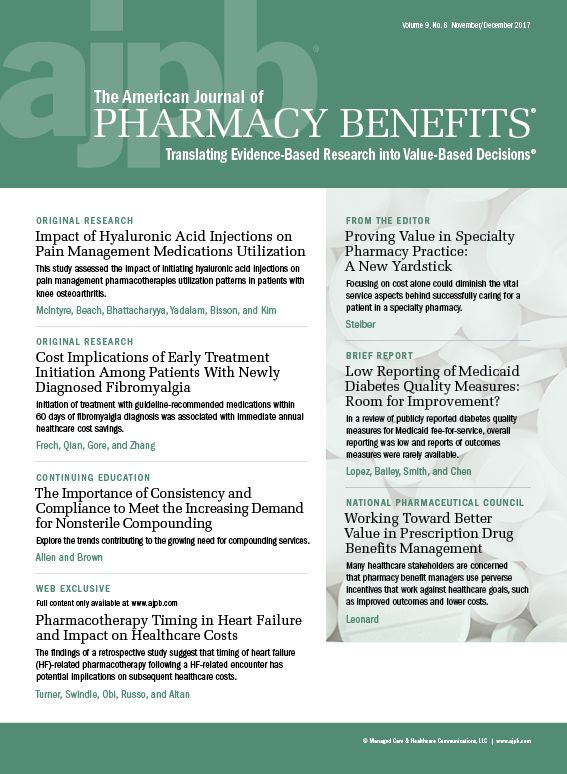Publication
Article
AJPB® Translating Evidence-Based Research Into Value-Based Decisions®
Proving Value in Specialty Pharmacy Practice: A New Yardstick
Author(s):
Focusing on cost alone could diminish the vital service aspects behind successfully caring for a patient in a specialty pharmacy.
The Focus on the Big Trends Starts with Cost
Unless you’ve been hiding under a rock, it would not be a surprise to hear that the top growth category in the pharma space is specialty pharmacy. The trends are very clear: On a per-patient basis, the spending on traditional products is declining, while spending is rising on the specialty side (Figure 1).
Finding a specialty pharmacy definition on which everyone can agree is challenging. The disease states contained within specialty pharmacy include cancer, rheumatoid arthritis, and multiple sclerosis. Knowing that specialty disease states are complicated, it is safe to assume that these complex drugs can be very expensive. CMS, in response to the growing number of Medicare Part D plans that were using specialty tiers, established a $670 minimum cost threshold that drugs must meet before plans can place them on a specialty tier. Although cost is an important factor to consider, cost alone could reduce the important service aspects behind successfully caring for a specialty pharmacy patient.
Once a product has been identified as being specialty, another question arises: What is the best practice setting or distribution strategy for that product? Those decisions are most often made by the manufacturer well in advance of the product’s approval. The growth in specialty products has closely paralleled the growth in specialty pharmacies; however, we as a profession, in the view of many, lag behind in clearly defining what is, or is not, a specialty pharmacy. Like all good markets, however, the business finds a way to create differentiation. In specialty, a key indicator is having obtained accreditation from 1 of the 4 leading accrediting bodies.
By the Numbers, Accredited Pharmacies and Drug Spend
Growth in accredited specialty pharmacies has been remarkable and pharmacies are chasing the specialty dollar by investing in accreditation (Figure 2).
Specialty pharmacies owned by pharmacy benefit managers and health plans fill more than 60% of the total specialty drug spend, principally because of their alignment with a patient’s prescription benefit coverage. Specialty is quickly approaching 50% of the spend from less than 3% of the total prescriptions filled, a concentrated mix (Figure 3). The more significant the spend on a particular specialty therapy, the greater the probability that the share of dispensing of that product will be disproportionately higher in payer-owned specialty pharmacies.
Follow the Patient and Their Disease State
In specialty, the common denominator is providing the best patient services possible to assure the best outcomes. It does not matter what “category” of specialty pharmacy one is in, because every operation is committed to being the best they can be.
While we continue to be blessed with existing and emerging products to treat many disease states, the reality, according to IMSQuintiles, is that the top 5 disease states constitute 75% of drug spend (Figure 4).
It stands to reason that if a pharmacy is going to be successful, it must incorporate some of these disease states. This is especially true in payer-owned specialty pharmacies, which, unlike the independents, likely offer a broad spectrum of disease programs.
Measuring Outcomes: Setting Specialty Up for Success
One mantra in specialty pharmacy is, “If you didn’t document it, you did not do it.” Well, that goes for measuring value, often in the form of quality metrics. Only in this way will specialty pharmacy be in a position to demonstrate its positive impact. Each therapeutic class or disease state presents itself with potential measures. Those measures can be based on multiple factors, including quality, improvement/cure, outcomes, adherence, cost, and potentially so many more. Often the measures can be subjective based on how the patient feels.
In most cases, the services provided by specialty go far beyond dispensing, and that value must be measured. While focused specialty pharmacies concentrate on key measures in their business, as a whole, standards have not been clearly established as an industry. The Pharmacy Quality Alliance (PQA) released its Specialty Core Measure Set to assess adherence and persistence for several important specialty therapies. These health-plan-level measures fill a gap in the market and will have a positive impact on appropriate medication use and patient outcomes.
The set of PQA-endorsed measures include:
1. Treatment of Chronic Hepatitis C: Completion of Therapy
2. Adherence to Antiretroviral Medications
3. Adherence to Non-Infused Disease-Modifying Agents Used to Treat Multiple Sclerosis
Right around the corner for PQA is Adherence to Non-Infused Biologic Medications Treating Rheumatoid Arthritis (autoimmune). The objective of the Specialty Core Measure Set used in its entirety, or individually, will enable key stakeholders such as specialty pharmacies, health plans, and pharmacy benefit managers to understand the impact of their quality initiatives to support the health and outcomes of specialty patient populations. Patient adherence to drug therapy is the top mission for all specialty pharmacies. By measuring adherence and persistence on 4 of the 5 top disease states, pharmacies can best assure optimal outcomes for patients. The plan is to leverage these core data sets and pair them with a payer’s service-level metrics, patient experience metrics, or other metrics, to holistically assess plan members’ medication use.
Value-Based Contracting
Specialty pharmacy has become a focal point of data convergence. In the case of specialty products, the interpretation and action taken by specialty pharmacy in the management of pharmaceutical care—using their professional expertise to reduce abandonment and improve adherence—is the point of differentiation.
The definition of value is generally understood as the result of quality divided by cost, or the health outcomes achieved per dollar spent. Value-based contracting involves payment or reimbursement based on indicators of value, such as patient health outcomes, efficiency, and quality. To get there, we must focus on key elements, such as: the number of dollars spent on a medication versus other associated healthcare costs.
Finding specific measures and calculating how those measures can be tracked against key benchmarks. For example, one could measure the sustained virologic response test results for hepatitis C products over a period of time to measure cure rates.
Providing portability in these measures as patients may go from one plan to another over the course of their treatment.
The 4 P’s: Patient, Providers, Pharma, and Payers
All 4 of the P’s fit in the data mix. Pharma and payers are interested in seeing measurable outcomes for the drugs prescribed to patients. Pharma want to claim that their product—if used correctly—will decrease the progression of disease, reduce visits to the emergency department, and achieve positive outcomes. Pharma wants to compare their product with others on the market to point out its efficacy.
The aligned interests of payers and their specialty pharmacy operations are key. They look for products that decrease cost, reduce hospital admissions, and improve patients’ quality of life by lessening their disability and reducing absences from work due to illness. Both pharma and payer stakeholders need access to comprehensive internal data, and they look to specialty pharmacies to provide that service. Specialty pharmacies must improve their ability to better measure outcomes if they want to make valid claims that because of their actions, the health outcome for the patient was improved. Lastly, both pharma and payers are reliant on the data specialty pharmacies provide to demonstrate that a product is having a positive, not negative, impact on the patient’s condition.
The American Journal of Pharmacy Benefits® (AJPB) is committed to providing you with peer-written and reviewed articles focused on the “real world” of managed markets specialty pharmacy practice. We invite you to enjoy this issue and pass it on!
We welcome your feedback on this topic and on any other topics you would like us to cover in future issues of AJPB®. Please reach out to us at [email protected] or [email protected]. And we also encourage you and your colleagues to subscribe to this unique journal by logging onto www.ajpb.com.
Dan Steiber, RPh, is executive vice president and editor-in-chief of The American Journal of Pharmacy Benefits®. Professionally, he is an industry-leading consultant and has been responsible for managed markets, commercial operations, and supply chain strategy. Mr Steiber has served in several senior positions in pharmacy, distribution, and industry over the course of his 40-year career.
Mr Steiber is a licensed pharmacist in Texas, Washington, California, and Pennsylvania. He is affiliated with several professional associations and publications and is a frequent speaker on behalf of many professional organizations. He graduated from Washington State University College of Pharmacy and has participated in a variety of postgraduate programs in law and business development/marketing at Harvard University and Northwestern University. Mr Steiber currently resides in Highland Village, Texas.







